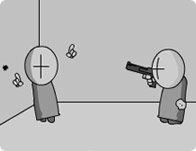The original name of this sport was called 'VOGELPIK'. It was very popular in Flanders around the time of 1792, and seems to have originated from the archery skills of the Middle Ages. 'VOGELPIK' is the early version of the modern game of Belgian darts. It consisted of a stuffed pigeon hung by a wire from the ceiling, and in its bill a needle in the horizontal position was attached. The player would balance the wire and try to spear a wooden board that was hung on the wall.
The modern version of Belgian darts employed a seven inch diameter straw board that the tapered, feathered darts were thrown against. The target was originally made from pressed straight rye straw. It had vari-colored circles which were separated by metal bands that divided the target into six separate scoring rings of varying numerical value.
The darts (PIKS) were, and are still made of birchwood, the feathers are select turkey feathers and the point is made from polished steel. They are precision made, accurate and correctly balanced with a brass weight. We at Standard Target and Dart have continued the old world tradition that our grandfather, Arthur VanHoutteghem, brought with him from Belgium over 90 years ago.
The target is made from end grain Basswood because it is the most durable and self-healing material on the market today. Solid brass rings are hydraulically inserted in to the target to separate the six different scoring rings. The outside edge of the target is finished with a polished solid brass band. Our Belgian dartboards come in two sizes, the original seven inch diameter and the nine inch diameter (actual size 8-3/4'), which our grandfather introduced in America over ninety years ago.
Belgian darts has remained a very popular game in the Belgium community since the 18th century. It is not only relaxing but also helps to develop coordination skills, precision and self-control.
Walk into any pub in the world and more likely than not, alongside a bar, a couple of taps, and some beaten up stools, there’ll be a dartboard somewhere in the establishment. In addition to being a professional sport, darts is also a classic pub game all over the Northern Hemisphere. It’s one of the few things the Scandinavians, the Irish, the Germans, and even the Americans all have in common. The game consists of throwing small “missiles” at a circular, fixed board, and can be played with as few as two people or as many as two full teams. So where exactly did one of our most beloved bar games start?
Darts originated in the U.K. sometime in the mid-19th century. It’s been said that the game first started with soldiers throwing short arrows at tree trunks or the bottom of a barrel. Wood would dry out and cracks would form, creating “sections” on their makeshift boards. Apparently some woodworkers even began paying their bar bills by making homemade dartboards and giving them to pubs! Dartboards used to be called “butts,” coming from the French word for target. The first set of proper darts was crafted using wood, lead for weight, and turkey feathers.
Darts is a free target shooting game on SIlvergames.com. Play online and throw tiny missiles to the round target. Your goal is to reduce your score to zero. Aim precisely and release your missile. You only have a couple of seconds to set the direction for the throw. The final dart must hit a number indicated by a yellow dot. This game is the same game as 801 and 501 darts, just with fewer starting points. Having less points to start will make the game much shorter but it also doesn't allow much room for error. If you get behind in 301 darts it is hard to catch back up before the other team goes out and wins the game.
Darts Rules & Basics

Game Pigeon Darts Hack
Many variations of darts exist, though the most commonly played version is 501. The correct placement of a fixed dartboard is 5 feet 8 inches from the ground, with the bullseye being the point of reference. The proper distance between player and board, from toeline to front of board, is just over 7 feet 9 inches.
According to the Professional Darts Corporation, each team (or individual player) starts out at 501, with the goal of working their way down to zero. Teams alternate taking turns, with each turn consisting of three dart throws per turn. At the end of each turn, the total number accrued from the three darts thrown is subtracted from 501; the bullseye is worth 50 points. The catch, however, is that in order to win, the final thrower on the team must reach zero with a double. That’s to say, if the team has 20 points left, the final thrower must hit the 10 twice. For odd numbers, the first dart must be used to change the number to an even (example, starting with 25 and scoring 5 points), then the doubling on the last two throws. Some variations of the game call for a “double start,” which incorporates this final process at the beginning as well. This is referred to as the “double in, double out” rule. Whichever team hits zero first wins. If neither team gets to zero in 20 turns, the team with the lower number of points wins. If the scores are tied at 20 turns, 10 additional rounds will be played. At 30 rounds, if the scores are still equal, the match concludes with a draw.
Game Pigeon Darts Strategy

Tempted to join a dart league yet? Maybe not. Tempted to head to your local pub and get to practicing over a beer? We thought so.